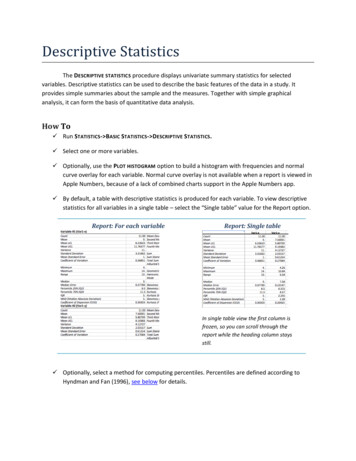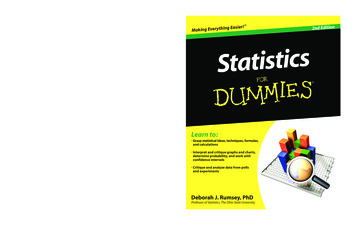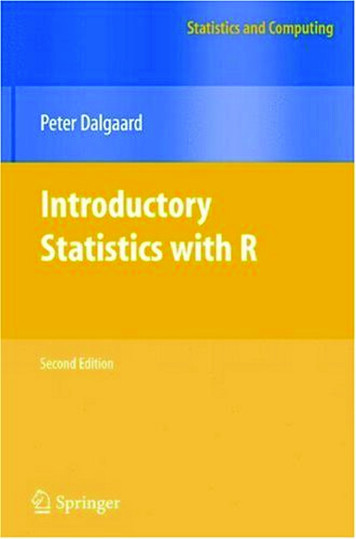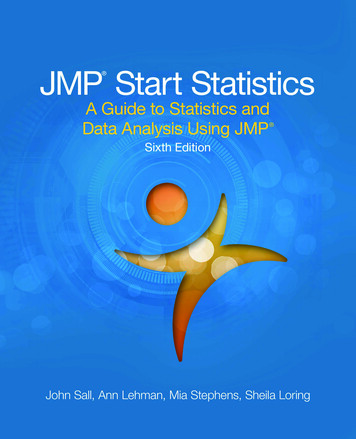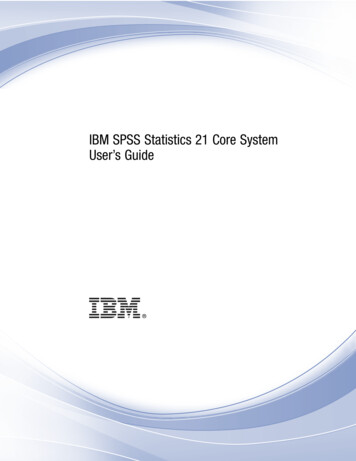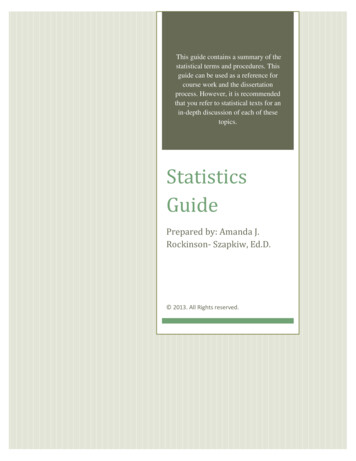
Transcription
This guide contains a summary of thestatistical terms and procedures. Thisguide can be used as a reference forcourse work and the dissertationprocess. However, it is recommendedthat you refer to statistical texts for anin-depth discussion of each of thesetopics.StatisticsGuidePrepared by: Amanda J.Rockinson- Szapkiw, Ed.D. 2013. All Rights reserved.
ContentsFoundational Terms and Constructs . 3Introduction to Statistics: Two Major Branches . 3Variables . 3Descriptive Statistics . 5Frequency Distributions . 5Central Tendency . 6Measures of Dispersion. 7Normal Distribution . 8Measure of Position . 10Inferential Statistics . 12Hypothesis Testing . 12Research and Null Hypothesis . 12Type I and II Error . 14Statistical Power. 15Effect Size . 16Non Parametric and Parametric . 16Assumption Testing . 17Parametric Statistical Procedures . 18t-tests . 18Independent t test . 18Paired Sample t test . 20Correlation Procedures . 21Bivariate Correlation . 21Partial Correlation . 22Bivariate Linear Regression. 23Analysis or Variance Procedures . 26One-way analysis of variance (ANOVA) . 26Factorial (or two-way) analysis of variance (ANOVA) . 27One-way repeated measures analysis of variance (ANOVA). 29Multivariate analysis of variance (MANOVA) . 301
Test Selection . 34Test Selection Chart . 34References Used to Create this Guide . 372
Foundational Terms and ConstructsIntroduction to Statistics: Two Major BranchesBroadly speaking, educational researchers use two researchmethods:Quantitative research is characterized by objective measurement,usually numbers.Qualitative research emphasizes the in depth understanding of thehuman experience, usually using words.Statistical procedures are sometimes used in qualitative research;however, they are predominantly used to analyze and interpret the data in quantitative research.Accordingly, statistics can be defined as a numerical summary of data. There are two majorbranches of statistics:Descriptive Statistics, the most basic form of statistics, are procedures for summarizing a groupof scores to make them more comprehendible. We use descriptive statistics to describe aphenomenon.Inferential Statistics are procedures that help researchers draw conclusions based oninformational data gathered. Researchers use inferential statistics when they want to makeinferences that extend beyond the immediate data alone.Before you can understand these two major branches of statistics and the different type ofprocedures that fall under each, you first need to understand a few basics about variables.VariablesA variable is any entity that can take on different values. We can distinguish between twomajor types of variables:1. Quantitative Variables – numeric (e.g., test score, height, etc.)2. Qualitative Variables – nonnumeric or categorical (e.g., sex, political party affiliation,etc)Variables are typically measured on one of four levels of measurement: (a) nominal, (b) ordinal,(c) interval or (d) ratio. The level of measurement of a variable has important implications for thetype of statistical procedure used.Nominal Scale: Nominal variables are variables that can be qualitatively classified into discrete,separate categories. The categories cannot be ordered. Religion (Christian, Jewish, Islam, Other),3
intervention or treatment groups (Group A, Group B), affiliations, and outcome (success, failure)are examples of nominal level variables.Ordinal Scale: Ordinal variables are variables thatcan be qualitatively classified into discrete, separatecategories (like nominal variables) and rank ordered(unlike nominal variables). Thus, with ordinalvariables, we can talk in terms of which variable hasless and which has more. The socioeconomic (SES)status of families (high, low, medium), height whenwe do not have an exact measurement tool (tall, short),military rank (private, corporal, sergeant), school rank(sophomore, junior, senior) and ratings (excellent, good, average, below average, poor; or agree,neutral, disagree) are all examples of ordinal variables. Although there is some disagreement, IQis also often considered an ordinal scale variable. Likert-type scale data is also ordinal data;however, in social science research, we treat it as ratio or interval level data.Interval Scale: Interval variables are variables that can be qualitativelyclassified into discrete, separate categories (like nominal and ordinal variables)and rank ordered (like ordinal variables), and measured. Interval variables havean arbitrary zero rather than a true zero. Temperature, as measured in degreesFahrenheit or Celsius, is a common example of an interval scale. For example,we can say that a temperature of 40 degrees is higher than a temperature of 30degrees (rank). Additionally, we can say that an increase from 20 to 40 degrees istwice as much as an increase from 30 to 40 degrees (measurement). However,since there is no arbitrary zero, we cannot say that it is twice as high.Ratio Scale: Ratio variables have all the characteristics of the preceding variables in addition toa true (or absolute) zero point on a measurement scale. Weight (in pounds), height (in inches),distance (in yards), and speed (in miles per hour) are examples of ratio variables.While we are discussing variables, let’s also review a few additional terms and classifications.When conducting research, it is important to identify or classify variables in the followingmanner:Independent variables (IV), also known as predictor variables in regression studies, arevariables we expect to affect other variables. This is usually the variable we, as the researcher,plan to manipulate. It is important to recognize that the IV are not always manipulated by theresearcher. For example, when using an ex post facto design, the IV is not manipulated by theresearcher (i.e., the researcher came along after the fact). IV used in an ex post facto design maybe are gender (male, female) or smoking condition (smoker, nonsmoker). Clearly, the researcher4
did not manipulate gender or smoking condition. However, the IV is the variable that ismanipulated or was affected.Dependent variables (DV), also known as criterion variables in regression studies, are variableswe expect to be affected by other variables. This is usually the variable that is measured.In this research question, what is the IV and DV?Do at-risk high school seniors who participate in a study skills program have ahigher graduation rate than at-risk high school seniors who do not participate ina study skills program?IV participation in study skills programDV graduation rateYou can visualize the IV and DV as follows:IV (cause; possible cause) DV (effect; outcome)Additional types of variables to be aware of include: Mediator variables (or intervening) – variables that are responsible for the relationshipbetween two variables (i.e., help to explain why the relationship exists).Moderating variables – a variable that influences the strength or direction of therelationship that exists between variables (i.e., specify conditions when the relationexists).Confounding variables are variables that influence the dependent variable and are oftenused as control variables.Variables of Interest – variables that are being studied in a correlational study, when itis arbitrary to use the labels of IV and DV.Descriptive StatisticsRemember that with descriptive statistics, you are simply describing a sample. With inferentialstatistics, you are trying to infer something about a population by measuring a sample taken fromthe population.Frequency DistributionsIn its simplest form, a distribution is just a list of the scores taken on some particular variable.For example, the following is a distribution of 10 students’ scores on a math test, arranged inorder from lowest to highest:5
69, 77, 77, 77, 84, 85, 85, 87, 92, 98The frequency (f) of a particular data set is the number of times a particular observation occursin the data. And the frequency distribution is the pattern of frequencies of the observations orlisting of case counts by category. Frequency distributions can show either the actual number ofobservations falling in each range or the percentage of observations (the proportion percategory). They can be shown using as frequency tables or graphics.Frequency Table- is a chart presenting statistical data that categorizes the values along with thenumber of times each value appears in the data set. See the example below.Table 1Distribution of Students’ Test ncy distributions also may be represented graphically; here are a few examples:A bar graph is a chart with rectangular bars. The length of each bar isproportional to the value that it represents. Bar graphs are used for nominaldata to indicate the frequency of distribution.A histogram is a graph that consists of a series of columns; each columnrepresents an interval having a category of a variable. The frequency ofoccurrence is represented by the column’s height. A histogram is useful ingraphically displaying interval and ratio data.A pie chart is a circular chart that provides a visual representation of the data(100% 360 degrees). The pie is divided into sections that correspond to a category of thevariable (i.e. age, height, etc.). The size of the section is proportional to the percentage of thecorresponding category. Pie charts are especially useful for summarizing nominal variables.Central TendencyMeasures of central tendency represent the “typical” attributes of the data. There are threemeasures of central tendency.The mean (M) is the arithmetic average of a group of scores or sum of scores divided by thenumber of scores. For example, in our distribution of 10 test scores,69 77 77 77 84 85 85 87 92 98/ 10 83.16
The mean is used when working with interval and ratio data and is the base for other statisticssuch as standard deviation and t- tests. Since the mean is sensitive to extreme scores, it is thebest measure for describing normal, unimodal distributions. The mean is not appropriate indescribing a highly skewed distribution.The median (Mdn) is the middle score of all the scores in a distribution arranged from highest tolowest. It is the midpoint of distribution when the distribution has an odd number of scores. It isthe number halfway between the two middle scores when the distribution has an even number ofscores. The median is useful to describe a skewed distribution. For example, in our distributionof 10 test scores, 84.5 is the median.69, 77, 77, 77, 84,84.585, 85, 87, 92, 98The median is useful when working with ordinal, ratio, and interval data. Of the three measuresof central tendency, it is the least effected by extreme values. So, it is useful to describe a skeweddistribution.The mode (Md) is the value with the greatest frequency in the distribution. For example, in ourdistribution of 10 test scores, 77 is the mode because it is observed most frequently. The mode isuseful when working with nominal, ordinal, ratio, or interval data.Table 2Levels of Measurement and the Best Measure of Central TendencyMeasurementNominalMeasure of Central TendencyModeOrdinalMedianIntervalSymmetrical data: MeanSkewed data: MedianRatioSymmetrical data: MeanSkewed data: MedianMeasures of DispersionWithout knowing something about how data is dispersed, measures of central tendency may bemisleading. For example, a group of 20 students may come from families in which the meanincome is 200,000 with little variation from the mean. However, this would be very differentthan a group of 20 students who come from families in which the mean income is 200,000 and3 of students’ parents make a combined income of 1 million and the other 17 students’ parents7
make a combined income of 60,000. The mean is 200,000 in both distributions; however, howthey are spread out is very different. In the second scenario, the mean is affected by the extremes.So, to understand the distribution it is important to understand its dispersion. Measures ofdispersion provide a more complete picture of the data set. Dispersion measures include therange, variance, and standard deviation.The range is the distance between the minimum and the maximum. It is calculated by taking thedifference between the maximum and minimum values in the data set (Xmax - Xmin.). The rangeonly provides information about the maximum and minimum values, but it does not say anythingabout the values between. For example, in our distribution of 10 test score, the range would be(98-69) 29.The variance of a data set is calculated by taking the arithmetic mean of the squared differencesbetween each value and the mean value. It is symbolized by the Greek letter sigma squared for apopulation and s2 for a sample. It tells about the variation of the data and is foundational to othermeasures such as standard deviation. In our example of 10 scores, the variance is 70.54.The standard deviation, a commonly used measure of dispersion, is the square root of thevariance. It measures the dispersion of scores around the mean. The larger the standarddeviation is, the larger the spread of scores around the mean and each other. In our example of10 scores, the standard deviation is the square root of 70.54, which is equal to 8.39. For normallydistributed data values, approximately 68% of the distribution falls within 1 SD of the mean,95% of the distribution falls within 2 SDs of the mean, and 99.7% of the distribution fallswithin 3 SDs of the mean. If our 10 scores were evenly distributed, with a M of 83.1 and SD of8.39, this mean 68% of the scores would fall between 91.49 and 74.71; 95% of the scores wouldrange between 99.88 and 66.32; 99.7% would fall between 108.27- and 57.93.Normal DistributionThroughout the overview of the descriptive statistics, the normal distribution (also called theGaussian distribution, or bell- shaped curve) was discussed. It’s important that we understandwhat this is. The normal distribution is the statistical distribution central to inferential statistics.8
Due to its importance, every statistics course spends lots of time discussing it, and textbooksdevote long chapters to it. One reason that it is so important is that many statistical procedures,specifically parametric procedures, assume that the distribution is normal. Additionally, normaldistributions are important because they make data easy to work with. They also it make it easyto convert back and forth from raw scores to percentiles (a concept that is defined below).The normal distribution is defined as a frequency distribution that follows a normal curve.Mathematically defined, a bell cure frequency distribution is symmetrical and unimodal. For anormal distribution, the following is true:oooo34.13% of the scores will fall between M and 1 SD.13.59% of the scores will fall between 1 SD & 2 SD.2.28% of the scores will fall between 2 SD & 3 SD.Mean median mode Q2 P50.Another way to look at this is how we looked at it above. For normally distributed data values,approximately 68% of the distribution falls within 1 SD of the mean, 95% of the distributionfalls within 2 SDs of the mean, and 99.7% of the distribution falls within 3 SDs of the mean.To further understand the description of the normal bell curve, it may be helpful to define theshapes of a distribution: Symmetry. When it is graphed, a symmetric distribution can be divided at the center sothat each half is a mirror image of the other. Uimodal or bimodal peaks. Distributions can have few or many peaks. Distributionswith one clear peak are called unimodal, and distributions with two clear peaks arecalled bimodal. When a symmetric distribution has a single peak at the center, it isreferred to as bell-shaped. Skewness. When they are displayed graphically, some distributions have many moreobservations on one side of the graph than the other. Distributions with most of theirobservations on the left (toward lower values) are said to be skewed right; anddistributions with most of their observations on the right (toward higher values) are saidto be skewed left. Uniform. When the observations in a set of data are equally spread across the range ofthe distribution, the distribution is called a uniform distribution. A uniform distributionhas no clear peaks.See graphic below.9
Graphic taken from: http://www.thebeststatistics.info.In our discussion of normal distribution, it is important to note that extreme values influencedistributions. Outliers are extreme values. As we discuss, percentiles and quartiles below, it maybe helpful to know that an extreme outlier is any data values that lay more than 3.0 times theinterquartile range below the first quartile or above the third quartile. Mild outliers are any datavalues that lay between 1.5 times and 3.0 times the interquartile range below the first quartile orabove the third quartile.Measure of PositionIn statistics, when we talk about the position of a value, we are talking about it relative to othervalues in a data set. The most common measures of position are percentiles, quartiles, andstandard scores (z-scores and t-scores).Percentiles are values that divide a set of observations into 100 equal parts or pointsin a distribution below which a given P of the cases lay. For example, 50% of scoresare below P50. For example, if 33 P50 , what can we say about the score of 33? That50% of individuals in the distribution or data set scored below 33.10
Quartiles divide a rank-ordered data set into four equal parts. The values that divide each partare called the first, second, and third quartiles; and they are denoted by Q1, Q2, and Q3,respectively. In terms of percentiles, quartiles can be defined as follows: Q1 P25, Q2 P50 Mdn, Q3 P75. For example, 33 P50 Q2.Standard scores, in general, indicate how many standard deviations a case or score is from themean. Standard scores are important for reasons such as comparability and ease of interpretation.A commonly used standard score is the z-score.A z-score specifies the precise location of each X value within a distribution. The sign of the zscore ( or -) signifies whether the score is above the mean or below the mean.You interpret z-scores as follows: A z-score equal to 0 represents a factor equal to the mean.A z-score less than 0 represents a factor less than the mean.A z-score greater than 0 represents a factor greater than the mean.A z-score equal to 1 represents a factor 1 standard deviation greater than the mean; a zscore equal to -1 represents a factor 1 standard deviation less than the mean. A z-scoreequal to 2, 2 standard deviations greater than the mean.For example, a z-score of 1.5 means that the score of interest is 1.5 standard deviations abovethe mean. A z-score can be calculated using the following formula:z (X - μ) / σX value, μ mean of the population,, σ standard deviation.For example, 5th graders take a national achievement test annually. The test has a mean score of100 and a standard deviation of 15. If Bob’s score is 118, then his z-score is (118 - 100) / 15 1.20. That means that Bob scores 1.20 SD above the average in the population. A z-score canalso be converted into a raw score. For example, Bob’s score on the test is X ( z * σ) 100 (1.20 * 15) 100 18 100 118.SPSS will compute z-scores for any continuous variable and save the z-scores to your dataset as anew variable. SPSS: Analyze Descriptive Statistics Descriptiveso Select variable(s) and click Save Standardized values as variables check box.11
Inferential StatisticsWith inferential statistics, you are trying to infer something about a population by measuring asample taken from the population.Hypothesis TestingA hypothesis test (also known as the statistical significance test) is an inferential statisticalprocedure in which the researcher seeks to determine how likely it is that the results of a studyare due to chance or whether or not to attribute results observed to sampling error. Samplingerror is chance or the possibility that chance affected the co-variation among variables in samplestatistics or the relationship between the variables being studied. In hypothesis testing, theresearcher decides whether to reject the null hypothesis or fail to reject the null hypothesis.Research and NullHypothesisThere are two types of hypotheses:First, there is the research hypothesis.The research hypothesis (also referred toas the alternative hypothesis) is atentative prediction about how change ina variable(s) will explain or causechanges in another variable(s). Example:H1: There will be a statisticallysignificant difference in high schooldropout rates of students who use drugsand students who do not use drugs.Second, the null hypothesis is theantithesis to the research hypothesis andpostulates that there is no difference orrelationship between the variables understudy. That is, results are due to chanceor sampling error. Example: H0: Therewill be no statistically significantdifference in high school dropout rates ofstudents who use drugs and students whodo not use drugs.How to Develop a Research QuestionThe formulation and selection of a research question can beoverwhelming. Even experienced researchers usually find it necessary torevise their research questions numerous times until they arrive at onethat is acceptable. Sometimes the first question formulated is unfeasible,not practical, or not timely.A well formulated research question, according to Bartos (1992): ask about the relationship between two or more variables be stated clearly and in the form of a question be testable (i.e. possible to collect data to answer the question) not pose an ethical or moral problem for implementation be specific and restricted in scope (your aim is not to solve theworld’s problems) identify exactly what is to be solved.Example of a Poorly Formulated Research Question: What is theeffectiveness of parent education for parents with problem children?(Note this is not specific or clear. Thus, it is not testable. What is meantby effectiveness, parent education, and parents with problem children?Since it is not clear it would be hard to test.)Example of a Well Formulated Research Questions: What is theeffect of the STEP parenting program on the ability of a parents to usenatural, logical consequences (as opposed to punishment) with their childwho has been diagnosed with Bipolar disorder? Or, Is the difference inthe number of times that parents use natural, logical consequences (asopposed to punishment) with their child who has been diagnosed withBipolar disorder who participate in the STEP parenting program asopposed to parents who participate in a parent support group? (Thesequestions are clearer and more focused. The researcher would now bebetter able to design an experimental study to compare the number ofnatural, logical consequences used by parent who have participated in12the STEP program and those who have not. )
Writing the Research and Null HypothesesBased on a Research QuestionsAfter your research question is formulated, you will write your research hypotheses.A good hypothesis has the following characteristics: the hypothesis stated the expected relationship between variablesthe hypothesis is testablethe hypothesis is stated simply and concisely as possiblethe hypothesis is founded in the problem statement and supported by research (Bartos,1992).Example Research Hypotheses: There will be a statistically significant difference in thenumber of times that parents use natural, logical consequences (as opposed to punishment)with their child who has been diagnosed with Bipolar disorder who participate in the STEPparenting program as opposed to parents who participate in a parent support group asmeasured by the Parent Behavior Rating Sale. (Note: This is non-directional; Directionalhypotheses specify the direction of the expected and indicate a one-tailed test will beconducted; whereas, nondirectional hypotheses indicate a difference is expected with nospecification of the direction. In the latter, a two-tailed test will be conducted.Example Null Hypothesis: There will be no statistically significant difference in the numberof times that parents use natural, logical consequences (as opposed to punishment) with theirchild who has been diagnosed with Bipolar disorder who participate in the STEP parentingprogram as opposed to parents who participate in a parent support group as measured by theParent Behavior Rating Sale.A hypothesis test is then an inferential statistical procedure in which the researcher seeks todetermine how likely it is that the results of a study are due to chance or sampling error.There are four steps to hypothesis testing:1. State the null and research hypothesis as just discussed.2. Choose a statistical significance level or alpha.a. An alpha is always set ahead of time. It is usually set to either .05 or .01 in socialscience research. The choice of .05 as the criterion for an acceptable risk of TypeI error is a tradition or convention, based on suggestions made by Sir RonaldFisher. A significance level of .05 means that if we reject the null hypothesis, weare willing to accept that there is no more than 5% chance that we made the13
wrong conclusion. In other words, with a .05 significance level, we want to be atleast 95% confident that if we reject the null hypothesis we have made the correctdecision.3. Choose and carry out the appropriate statistical test.4. Make a decision regarding hypothesis (i.e. reject or fail to reject the null hypothesis).a. If the p-value for the analysis is equal to or lower than the significance levelestablished prior to conducting the test, the null hypothesis is rejected. If the pvalue for the analysis is more than the significance level established prior toconducting the test, the null hypothesis is not rejected. Let’s say we set our alphalevel at .05. If our p-value is less than .05 (p .02), we can consider the results tobe statistically significant, and we reject the null hypothesis.Information derived from Rovai, et al. (2012)Type I and II ErrorThe purpose of an inferential statistical procedure is to test a hypothesis (es). It is important tonote that there is always the possibility that you could reach the wrong conclusions in youranalysis. After you have determined the results of your statistical tests, you will decide to rejector fail to reject the
The mean is used when working with interval and ratio data and is the base for other statistics such as standard deviation and . t - tests. Since the mean is sensitive to extreme scores, it is the best measure for describing normal, unimodal distributions. The mean is not appropriate in de




